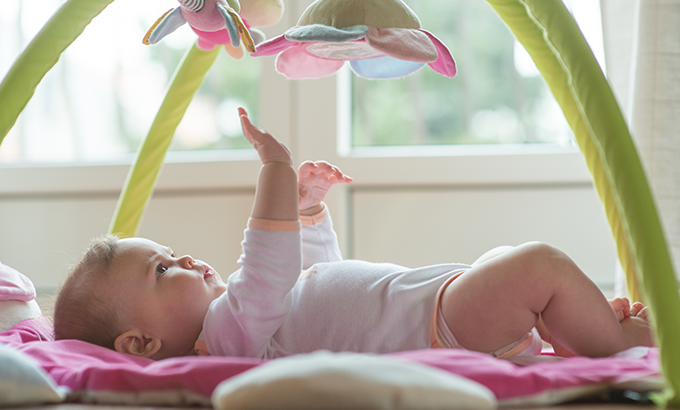At this time, your baby may also start to show interest in objects and toys that he/she can touch or hold. Choose toys that are lightweight, easy to grasp by hand, too big to swallow, and have no pointed corners. Examples include hardcover and picture books, soft blocks, wooden and plastic spoons, measuring cups, plush toys, rattles, balls, and singing toys. As long as the toys are safe, don’t limit your creativity, but stay away from shiny wrapping papers or plastic bags that can easily cover the baby’s mouth and nose and leave him breathless.

Other games you can play in the third month include:
Roll together.
Lie side by side with your baby so that he or she develops the ability to turn and encourage him or her to turn towards you. Your baby will try to do this using her whole body, which we call rolling. At first, it is usually easy for the baby to roll sideways and then return to the supine position. You don’t need to push or pull the baby because your baby will perfect this skill on their own over time.

Touch and feeling.
As your baby begins to open her palms over time, put things with different textures (soft, smooth, hairy, bumpy) in her palm. See what textures your baby likes.
Don’t teach me how to hold.
Put a toy or any object in your daughter’s or son’s hand. Have him hold it, feel it, and move it. Try this with objects that rattle, sing, and make sounds. When your baby manages to make a sound from that object and is surprised, pretend to be surprised too.

Let him do the exercises.
Place your baby on a soft floor where he can play and put his toys next to him. In this way, he/she will both practice reaching for and hitting the toys and discover different shapes and textures. Another thing you can do for the development of reaching and hand grip skills is to put him in the baby seat and put various objects in front of, next to, just below and above the eye level. These games contribute to the development of the baby’s depth perception and eye-hand coordination.
Make them laugh.
Almost all babies like to be lightly tickled. Especially if you do these tickles with laughter and exaggerated facial expressions. Or try blowing on the baby’s belly. The baby will be stunned at first, but these movements will not only make him giggle in time, but will also cheer him up and make him laugh.
